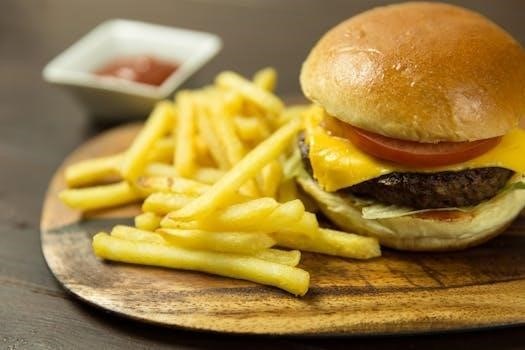This dish is a quick and easy meal often made in one skillet․ It combines ground beef, pasta, and a creamy cheese sauce, providing a convenient and tasty dinner option․ Often compared to a boxed meal, it’s easy to modify․
What is Hamburger Helper Cheeseburger Macaroni?
Hamburger Helper Cheeseburger Macaroni is a popular dish, often recognized for its convenience and family-friendly appeal․ It typically consists of ground beef, pasta – commonly elbow macaroni or mini penne – and a cheesy sauce, all combined in a single skillet․ This dish is designed to be a quick and easy meal solution, often prepared in about 30 minutes․ While many know it as a boxed product, homemade versions using fresh ingredients are also common․ The homemade versions often feature a richer flavor profile, with the use of fresh onions, garlic, and real cheese․ The main goal of this meal is to offer a hearty, satisfying, and simple dinner, perfect for busy weeknights․

Basic Cooking Instructions
The basic cooking process involves browning ground beef, adding liquids and pasta, and simmering until the pasta is tender․ This method is used for both boxed and homemade versions, ensuring a quick meal․
Browning the Ground Beef
To begin, place a large skillet over medium-high heat and add the ground beef․ Cook the beef, breaking it apart with a spoon or spatula, until it is completely browned and no longer pink․ This typically takes about 6 to 8 minutes․ Ensure that you are stirring constantly to break up the beef into small chunks for even cooking․ It’s important to drain any excess grease from the skillet after the beef is browned to prevent the final dish from being too oily․ This step is crucial for both skillet and homemade versions․ Once browned and drained, return the beef to the skillet, ready for the next stage of the recipe․
Adding Liquids and Pasta
After browning and draining the ground beef, it’s time to add the liquids and pasta to the skillet․ This usually involves pouring in hot water and milk, the amounts of which may vary depending on the specific recipe․ Then, add the uncooked pasta, such as elbow macaroni or mini penne, to the skillet along with the liquid․ Stir everything together to ensure the pasta is well combined and submerged in the liquid․ Bring the mixture to a boil, stirring occasionally; This step is essential to start the cooking process for the pasta and allow it to absorb the liquids effectively, preparing it for the simmering stage․
Simmering the Mixture
Once the mixture has reached a boil, reduce the heat to low and cover the skillet with a lid․ This simmering process is crucial for cooking the pasta thoroughly and allowing it to absorb the liquids․ Let the mixture simmer for approximately 10 to 12 minutes, stirring occasionally to prevent sticking and ensure even cooking․ The simmering step allows the pasta to soften and the sauce to thicken․ The pasta should be cooked until it is tender․ It’s important to watch the mixture carefully during this process, as the liquid may evaporate, requiring small adjustments to maintain proper consistency․
Checking for Pasta Tenderness
After simmering for the recommended time, it’s essential to check if the pasta is cooked to the desired tenderness․ Use a fork to gently poke a few pieces of pasta․ If the pasta is soft and easily pierced, it’s likely done․ If the pasta still feels firm or chewy, continue to simmer the mixture for a few more minutes․ The exact cooking time may vary slightly depending on the type of pasta used and your preferred texture․ If needed, you can remove the lid during this final cooking stage to allow any excess liquid to evaporate․ Be sure to stir the mixture occasionally while doing so to achieve the desired consistency․
Variations and Add-ins
This dish is easily customizable․ Consider adding cooked bacon, diced tomatoes, or pickles for extra flavor․ Different pasta shapes and extra cheese can also enhance the dish to your liking․
Adding Bacon and Tomatoes
To elevate your Hamburger Helper Cheeseburger Macaroni, consider incorporating cooked bacon and diced tomatoes; The smoky flavor of bacon adds a delightful richness, while the tomatoes introduce a touch of acidity and freshness that cuts through the creamy sauce․ Simply cook the bacon until crispy, crumble it, and stir it into the dish just before serving; For the tomatoes, fresh or canned diced tomatoes work well; add them at the same time as the bacon․ The combination creates a more complex and satisfying flavor profile, making your meal even more enjoyable․ These additions transform the basic dish into something more gourmet and flavorful․ Remember to adjust the amount of bacon and tomatoes to your preference, ensuring a perfect balance of taste and texture in every bite․
Incorporating Pickles
Adding pickles to your Hamburger Helper Cheeseburger Macaroni introduces a surprising and delightful tangy twist․ The sharp, vinegary flavor of pickles complements the richness of the cheese sauce and the savory ground beef․ Finely chop your favorite pickles, whether dill or sweet, and stir them into the mixture just before serving․ This addition provides an unexpected burst of zest that enhances the overall taste experience․ Pickles not only add flavor but also a subtle crunch, which adds a nice contrast to the soft pasta and creamy sauce․ The amount of pickles you use is adjustable to your taste, so experiment to find the perfect balance of tang․ This simple addition can make your meal more interesting and delicious․
Using Different Types of Pasta
While the classic Hamburger Helper often uses elbow macaroni, experimenting with different pasta shapes can add variety to your dish․ Mini penne, for instance, is a great alternative that cooks evenly and holds the sauce well․ You can also try using rotini, shells, or even small spirals․ The key is to choose a pasta shape that is similar in size and cooking time to elbow macaroni, ensuring it cooks properly in the allotted time․ If using a larger or thicker pasta, you might need to adjust the cooking time slightly or add a bit more liquid․ Keep in mind that different pasta shapes can alter the overall texture of your dish, making each version uniquely enjoyable․ Don’t hesitate to explore various pasta types to discover your favorites in this comforting meal․
Adding Extra Cheese
Enhancing the cheesy flavor of your Cheeseburger Macaroni is simple by incorporating extra cheese․ For a richer taste, consider stirring in some sharp cheddar cheese at the end of the cooking process, ensuring it melts smoothly into the sauce․ You can also experiment with other cheese varieties like Monterey Jack, Colby, or even a blend of your favorites․ Adding a handful of shredded cheese right before serving will give the dish an extra gooey and satisfying texture․ Remember to stir until the added cheese is completely melted and evenly distributed throughout the pasta and sauce․ This simple addition can elevate the dish to new levels of cheesiness, making it even more comforting and indulgent․ Adjust the amount of extra cheese to your taste preferences․

Homemade vs․ Boxed Versions
Homemade versions of this dish offer fresher ingredients and more flavor control compared to boxed mixes․ The ability to customize the cheese and other components makes it a superior choice․
Advantages of Homemade Version
Opting for a homemade version allows for greater control over the ingredients, ensuring a dish with fresher and higher-quality components․ Unlike the boxed versions, you can adjust the seasoning and cheese levels to perfectly match your preferences․ The absence of artificial flavors and preservatives found in pre-packaged meals contributes to a healthier and more natural taste․ Additionally, using your own choice of pasta and cheese allows for a fully customized meal․ The homemade version provides a significantly more flavorful and satisfying meal, with the freedom to add extra ingredients like bacon or tomatoes․ This flexibility creates a dish that is not just convenient but also delicious․

Cooking Methods
This dish can be prepared using various cooking methods․ The most popular methods include skillet cooking on the stovetop and microwave preparation, offering flexibility based on available time and equipment․
Skillet Instructions
To prepare this dish in a skillet, begin by browning the ground beef over medium-high heat, breaking it into smaller pieces as it cooks․ Once the beef is fully cooked, drain any excess fat․ Next, add the required liquid, often a combination of water and milk, to the skillet along with the pasta and sauce mix․ Bring the mixture to a boil, then reduce heat to a simmer, cover, and cook for about 10 to 12 minutes, or until the pasta is tender, stirring occasionally to prevent sticking․ If needed, uncover and cook for a few additional minutes to reach the desired consistency․ The time to cook will vary depending on the type of pasta․
Microwave Instructions
For a quicker method, Hamburger Helper Cheeseburger Macaroni can be prepared in the microwave․ Combine the cooked ground beef, liquids, pasta and sauce mix in a microwave-safe dish․ Be sure to use a dish large enough to accommodate the ingredients with room to spare to prevent boil-overs․ Microwave on high for 14 to 19 minutes, stirring every 7 minutes to ensure even cooking and prevent sticking․ The pasta should be tender when finished, and the sauce will thicken as it stands․ Be cautious when removing the dish from the microwave as it will be hot․ Adjust cooking time as needed based on your microwave’s power․

Tips and Tricks
Adjust liquid amounts as needed for desired consistency, and consider using gluten-free pasta and flour alternatives․ Remember to stir frequently and check for doneness․ Be sure to test the pasta for tenderness․
Adjusting Liquid Amounts
When preparing Hamburger Helper Cheeseburger Macaroni, achieving the perfect sauce consistency is crucial, and this often involves adjusting the liquid amounts․ The recipe typically calls for a specific amount of water and milk, but several factors can influence how much liquid you actually need․ If you notice that the pasta is absorbing the liquid too quickly and the sauce is becoming too thick before the pasta is fully cooked, you should add a bit more water or milk, a quarter cup at a time, until you reach the desired consistency․ Conversely, if the sauce is too watery even after the pasta is cooked, you may need to remove the lid and simmer the mixture for a few more minutes, allowing the excess liquid to evaporate․ This flexibility in adjusting the liquid is key to preventing the dish from becoming either too dry or too soupy, ensuring a creamy and delicious outcome․ Always check the pasta, and add more liquid if necessary․
Using Gluten-Free Alternatives
Adapting Hamburger Helper Cheeseburger Macaroni for a gluten-free diet is quite achievable with a few simple substitutions․ The most significant change involves the pasta component; instead of traditional wheat-based pasta, opt for gluten-free alternatives such as mini penne, rice-based pasta or corn-based pasta․ These gluten-free pastas cook similarly to their wheat counterparts, maintaining a good texture in the dish․ Additionally, when making a homemade version, ensure that the flour used for the cheese sauce is a gluten-free blend․ A good gluten-free flour mix will help thicken the sauce effectively․ Always check the labels of all your ingredients to confirm they are certified gluten-free to avoid cross-contamination․ With these modifications, you can enjoy a delicious gluten-free version of this classic comfort meal․

Be First to Comment